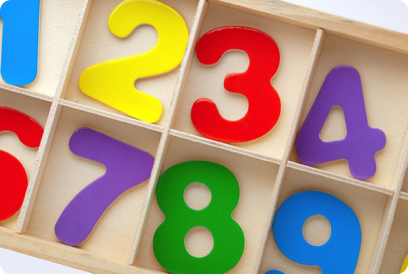Mathematics
Our Mathematics curriculum is rooted in hands-on learning. The child learns by doing, the hands leading the mind, using the carefully designed Montessori materials. These manipulatives put abstract ideas into a concrete form that makes sense to the young child. The materials are organized in a specific sequence beginning with the simplest, most concrete representation of the subject matter, then make a gradual progression to the abstract. Our teachers guide the children to make "real world" connections for the mathematical skills and concepts they discover.
Our mathematics curriculum includes the following topics and more:
- One-to-one correspondence
- Quantity and symbol recognition of numbers up to 10,000
- Skip counting
- Decimal system
- Squaring and cubing
- Number patterns
- Geometry
- Fact families for addition, subtraction, multiplication, and division
- Coins and money
- Time
- Measurement and estimating
- Data analysis and probability
- Problem solving
Overview of Our Mathematics Program
Each child begins with pre-math activities that teach one-to-one correspondence and the relationship between symbol and quantity for the numbers 0 to 9. Using the specially-designed Montessori manipulatives, our students learn to associate the names of the numbers, the written symbol for the numbers, and the fact that each number represents a certain quantity.
Once a student has mastered the work for the numbers 0 to 9, he/she is ready to learn to associate the quantities, names, and symbols for the teens and tens. He/she uses the Montessori materials to learn linear counting, skip counting, squaring, and cubing. By using these materials, a child discovers that things in math are linear and follow a definite pattern.
Our students work with the decimal system simultaneously. The teacher presents place value to the child using the Montessori Unit Beads, Ten Bars, Hundred Squares, and Thousand Cubes. The child learns that zero can give a greater value to a number, and learns quantities, names, and symbols up to 10,000.
Each child gains a sensorial impression of addition, multiplication, subtraction, and division, along with the relationships between the operations, as they begin to work with more advanced arithmetic materials. Using these materials, the student explores, discovers patterns, and memorizes the addition, subtraction, multiplication, and division tables.
Over time, the student becomes less and less dependent on the materials to do the operations until the child realizes the materials are starting to hinder his/her efficiency. At this point, the child is ready for more abstract arithmetic work, such as the concepts of exchanging and equivalencies.
In addition to arithmetic, other mathematical areas that are covered in our curriculum include geometry, fractions, money, time, measurement, data analysis, and problem solving. There is no limit to our mathematics curriculum, and our teachers are excited to meet the advanced needs of our precocious students using our Elementary Montessori materials and lessons.
More Information
For more information on how the mathematic materials in the classroom help the child make specific mathematical
discoveries, please visit this excellent website: http://www.justmontessori.com/math/
and watch the YouTube video below.
Overview of Mathematics in a Montessori Classroom
Curriculum Quick Links:

